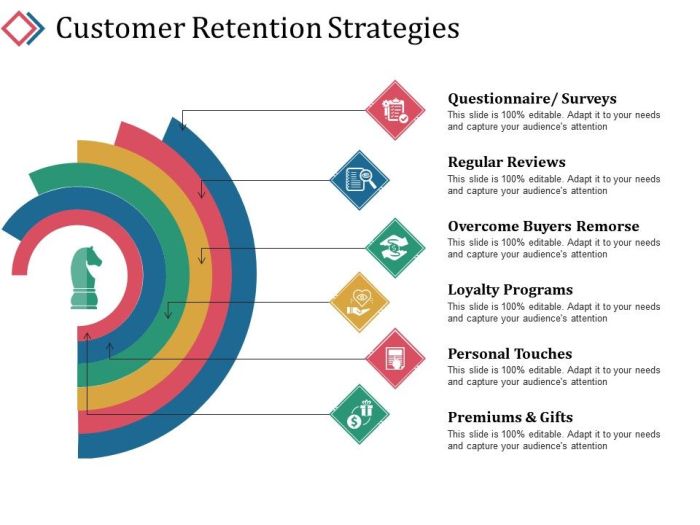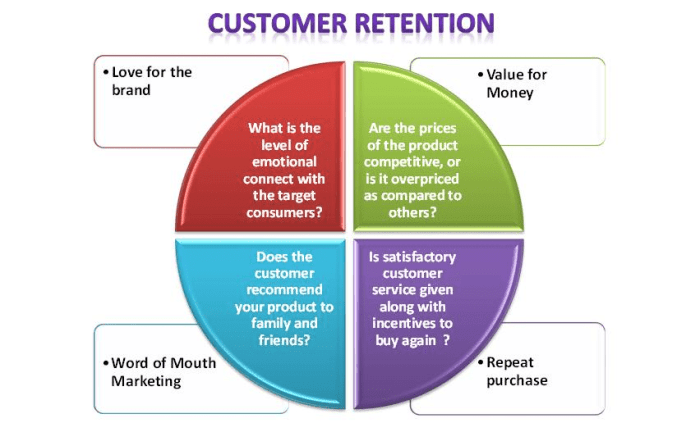Developing a Customer Retention Plan dives into the crucial aspects of retaining customers for business growth, shedding light on the significance of customer loyalty and personalized strategies. Get ready to explore the ins and outs of customer retention in this engaging journey!
Importance of Customer Retention

Customer retention is crucial for business growth as it focuses on keeping existing customers happy and satisfied, leading to increased loyalty and repeat purchases. By prioritizing customer retention, businesses can benefit in various ways compared to solely focusing on acquiring new customers.
Benefits of Focusing on Retaining Existing Customers
- Higher Customer Lifetime Value: Existing customers tend to spend more over time, making them more profitable in the long run.
- Lower Cost of Sales: Acquiring new customers can be expensive, while retaining existing ones is more cost-effective.
- Word of Mouth Marketing: Satisfied customers are more likely to recommend your business to others, leading to organic growth.
- Increased Customer Engagement: Repeat customers are more engaged with your brand, providing valuable feedback and insights.
Impact of Customer Retention on Long-Term Profitability
- Stable Revenue Streams: Retained customers provide a reliable source of revenue, reducing fluctuations in sales.
- Cost Savings: Retaining customers is more affordable than constantly acquiring new ones, leading to improved profitability.
- Competitive Advantage: Loyal customers are less likely to switch to competitors, giving your business a competitive edge in the market.
Understanding Customer Behavior
In order to develop an effective customer retention plan, it is crucial to understand customer behavior and what influences their loyalty to a business.
Analyze the factors that influence customer loyalty:
- Quality of products or services
- Pricing and promotions
- Customer service experience
- Brand reputation and trust
Identify different customer segments and their retention needs:
- New customers may need more guidance and support to establish loyalty
- Returning customers may appreciate personalized offers or rewards
- Loyal customers may value exclusivity and VIP treatment
- At-risk customers may require special attention to prevent churn
Describe how customer feedback can help in developing a retention strategy:
- Feedback provides insights into customer preferences and pain points
- Feedback helps in identifying areas for improvement in products or services
- Feedback can be used to tailor retention tactics based on customer suggestions
Developing a Customer Retention Strategy
Creating a personalized retention plan is crucial for keeping customers engaged and loyal to your brand. By understanding their preferences and behaviors, you can tailor your strategies to meet their needs effectively.
Key Steps in Creating a Personalized Retention Plan
When developing a customer retention strategy, consider the following key steps:
- Segment Your Customers: Divide your customer base into different segments based on demographics, behavior, or preferences.
- Identify Customer Needs: Understand what each segment values the most and how your products or services can meet those needs.
- Implement Personalization: Customize your marketing messages and offers to resonate with each customer segment.
- Monitor and Adjust: Continuously track the effectiveness of your retention plan and make adjustments as needed to improve results.
The Role of Data Analytics in Understanding Customer Preferences
Data analytics plays a crucial role in understanding customer preferences by:
- Gathering Customer Data: Collecting and analyzing data on customer interactions, purchase history, and feedback.
- Identifying Patterns: Recognizing trends and patterns in customer behavior to predict future preferences and actions.
- Personalizing Experiences: Using data insights to tailor marketing strategies and offers to individual customer preferences.
Examples of Successful Customer Retention Strategies
Several well-known companies have implemented successful customer retention strategies, including:
- Amazon: Utilizes personalized product recommendations based on customer browsing and purchase history.
- Starbucks: Offers a loyalty program that rewards customers with free drinks and discounts based on their purchase frequency.
- Netflix: Creates personalized content recommendations based on user viewing habits and ratings.
Implementing Retention Programs: Developing A Customer Retention Plan

Implementing retention programs is crucial for companies looking to build long-term relationships with their customers. These programs are designed to keep customers engaged, satisfied, and loyal to the brand. By offering incentives, rewards, and personalized experiences, businesses can increase customer retention and drive repeat purchases.
Types of Retention Programs, Developing a Customer Retention Plan
- Rewards Programs: These programs offer customers points, discounts, or freebies for making repeat purchases.
- Exclusive Offers: Providing exclusive deals and promotions to loyal customers can make them feel valued and encourage them to continue buying from the company.
- Personalized Communication: Sending personalized messages, emails, or offers based on customer preferences can enhance the overall customer experience and strengthen the relationship.
- Customer Support: Offering exceptional customer service and support can help retain customers by addressing their concerns and resolving issues promptly.
Measuring Retention Program Effectiveness
- Customer Retention Rate: Calculate the percentage of customers who continue to do business with the company over a specific period.
- Repeat Purchase Rate: Monitor how frequently customers make repeat purchases and analyze trends over time.
- Net Promoter Score (NPS): Measure customer satisfaction and loyalty by asking customers how likely they are to recommend the company to others.
Integrating Retention Programs with Marketing Efforts
- Segmentation: Divide customers into groups based on their behavior, preferences, or demographics to tailor retention programs effectively.
- Omni-Channel Approach: Use multiple channels such as email, social media, and in-store promotions to reach customers and reinforce retention efforts.
- Data Analysis: Analyze customer data and feedback to fine-tune retention programs and make informed decisions on marketing strategies.
